August, 1959
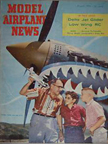
Model Airplane News Cover for August, 1959
Click to Enlarge
Here's what thethe "On the Cover" blurb had to say about this Big/Little photo:
"... Famous stunt flyer Paul Mantz used a Thimble-Drome Flying Tiger model to plan air action scenes for his TV series "Rogue for Hire" to be released in Fall 1959. Young admirers Tommy Sparks and Mike James were lucky to be on hand for a demonstration by Mantz. The P-40 in the background is the real thing..."
This is "almost true". Paul Mantz was one of the best air racers and stunt pilots in the world. (He called it "Precision Flying"). His achievements are both legendary and the plot of many aviation fims:
- He taught Amelia Earhart long distance flying
- He was kicked out of the Army Air Corps for stunt flying
- He flew a biplane through a hangar with only 5 feet to spare
- He won the Bendix for three consecutive years (1946–1948) with over $125,000.00 in winnings
- He was the pilot for the TV series Sky King
Mr. Mantz died in a crash of the "cobbled together" airplane in the original Flight of the Phoenix
Unfortunately, "Rogue for Hire" was not "his" series (although he did stunt flying for the few episodes that were filmed) The true story is that Rogue for Hire was one of a number of projects by the company Gross-Kasne. In the 1950's Jack J Gross and Philip Kasne made some low budget feature films, and had a string of successful television series behind them, several starring Thomas Mitchell, another being The Lone Wolf with Louis Hayward. In 1957 they became more ambitious making Adventures of a Jungle Boy and African Patrol both on location in Africa. Originally Rogue for Hire was to have been called by the imitative title Have Plane Will Travel. Filming began in 1959 with English star Jerome Thor in Hollywood, the plan had been to make this an American/British co-production. Movie stunt pilot Paul Mantz contributed some sequences, about which it was reported in June 1959 that "several episodes have been completed." It does seem six were actually finished. The script for one episode, Operation Jaguar, survives, but the rest was lost.
Click here to learn more about Paul Mantz's spectacular career.About the P-40 "Warhawk"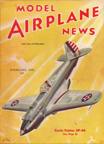
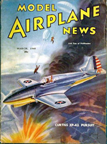
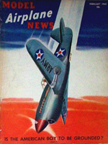
Curtiss "XP-42"
Model Airplane News Cover Art for February, 1939, March, 1940, and February, 1942
by Jo Kotula
Click to Enlarge
This is the saga of the evolution of the Curtiss P-36 "Hawk" into the P-40 "Warhawk" of Flying Tiger fame. In March of 1940, development had reached the "XP-42" stage and the MAN cover artist portrayed the elegant streamlined image of this version. Like many of these covers, that which was artistic and dramatic was not necessarily the best airplane. Here is the story:
Curtiss wanted to get into the business of producing high speed monoplane fighters and began with a private venture called the "Model 75" based on a design by former Northrop engineer Donovan Berlin.
P-36 Hawk: The prototype "Model 75" first flew in May 1935,and was sent to Wright Field, Ohio, to compete in the USAAC fly-off for a new single-seat fighter. The contest was delayed because the Seversky entry crashed on the way to the contest. Curtiss took advantage of the delay to install a more powerful engine and to rework the fuselage, adding the distinctive scalloped rear windows to improve rear visibility. (Seversky used the hiatus to install retractable landing gear -- see our discussion of the cover of the February, 1941 Issue.) The fly-off finally took place in April 1936 but the new engine failed to deliver its rated power. Although its competitor, the Seversky P-35, also underperformed and was more expensive, it was still declared the winner and awarded a contract for 77 aircraft.
Then, on 16 June 1936, Curtiss received an order from USAAC for three prototypes designated Y1P-36. The USAAC was concerned about political turmoil in Europe and about Seversky's ability to deliver P-35s in a reasonable timeframe and therefore wanted a backup fighter. The new aircraft performed so well that it won the 1937 USAAC competition with an order for 210 newly designated P-36 "Hawk" fighters.
YP-37: In early 1937, the USAAC ordered Curtiss to adapt one P-36 to the new liquid-cooled turbo-supercharged Allison V-1710 engine with 1,150 hp. Designated XP-37, the aircraft used the original Model 75 airframe with radiators mounted on the sides of the fuselage around the engine. The cockpit was moved far to the rear to make room for the radiators and to balance the aircraft. The aircraft flew in April 1937, reaching 340 mph at 20,000 ft. Although the turbo-supercharger was extremely unreliable and visibility from the cockpit on takeoff and landing was virtually nonexistent, the USAAC was sufficiently intrigued by the promised performance to order 13 service test YP-37s. Featuring improved aerodynamics and a more reliable turbo-supercharger, the aircraft first flew in June 1939. However, the powerplant remained unreliable and the project was cancelled.
XP-42 (March, 1940 M.A.N. Cover )In an attempt to improve the aerodynamics of the air-cooled piston engines, the fourth production P-36A (serial 38-004), designated the XP-42, was equipped with a long streamlined cowling resembling that of a liquid-cooled engine. Twelve different designs were tried with little success - although the aircraft was faster than a standard P-36A, engine cooling problems were never resolved. Since the new P-40 was faster, the project was cancelled.

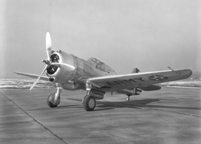

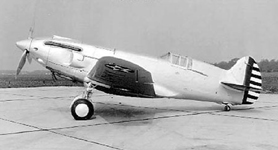
Middle: P-36 Right: YP-37
Left: The 1935 USAAC Flyoff results: (1) Republic Seversky P-35 (2) Curtiss Model 75 (P-36) (3) Northrop 3A

Curtiss "XP-42"
Donovan Berlin Design Patent D-135,749
Click to Enlarge
Here is a video of the Curtiss P-36 in action:
Jo Kotula revisited the P-40 several times. On the left is a print entitled "Warbird" that was done for the Curtiss Corporation. On the right is the "Box Art" for the Aurora kit for the P-40.
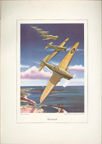
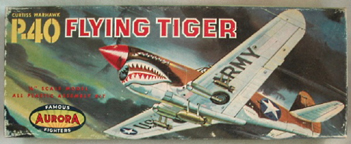
Artwork by Jo Kotula
"Warbird" print for the Curtiss Corporation
Aurora Plastic Model of the P-40
Click to Enlarge
Click Here for more information about the Curtiss "XP-42".

Click to go back and select another cover.
Counter for the Entire Site (not just this page..)
Home | About Lindy | Last Week's Reviews | Upcoming Events | 1940s Collecibles
The Guide - Establishments - Travel - Accessories
Music | Links | Photo Gallery | Extras | Contact